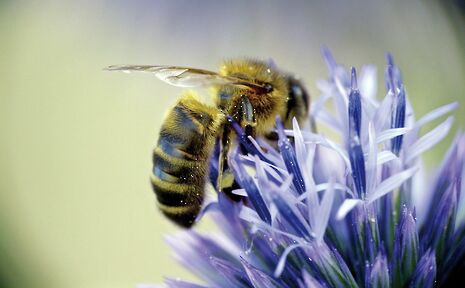Pollinators in decline
Sophie Cook reports on the dangers threatening our bee populations

Ecosystem services are defined as the numerous and varied benefits which we as humans gain from the natural world. Pollination is one such service which has an enormous impact on agricultural systems. According to the UN, at least one third of the world’s agricultural crops depend on the work of pollinators. In 2005, their global economic value was estimated to be around £132 billion. A UK government study found that pollinators add a value of around £600 million per year to UK crops. Unfortunately, the benefits these organisms provide are coming under increasing pressure from climate change and intensifying agricultural practices.
Pollination is the transfer of pollen grains from the male part of the plant (the anther) to the female part (the carpel). This can occur within the same plant causing self-fertilisation or between different individuals, so-called cross-pollination. Cross-pollination is the more desirable outcome, as it increases genetic diversity among populations, making them more resistant to the spread of diseases and environmental change.
Domestic honeybee populations are being increasingly relied upon to pollinate large swathes of agricultural land. In 2017, 1.7 million honeybee colonies were transported to California to pollinate almond plantations. These trees are responsible for 80% of the global almond crop and mean big business for American beekeepers.
In the UK, we have over 250 different bee species. The UK apple industry is particularly at risk from the decline of UK bee populations. It has been estimated that wild UK pollinators add £37 million per year to the value of Gala and Cox apples. They not only increase apple yields, but also apple quality – especially their firmness and texture.
“There has been a 60% decline in honeybee populations from 1947-2008”
In 2015, the Status and Trends of European Pollinators (STEP) project found that 9.2% of Europe’s wild bees are now threatened with extinction, and US National Agriculture Statistics show that there has been a 60% decline in honeybee populations between 1947-2008. One of the main reasons for this decline is due to bee ‘colony collapse disorder’ (CCD). This is the unexplained absence of live or dead adult worker bees in and around the hive, despite abundant brood, honey and pollen levels. Many of the factors implicated in this worrying phenomenon stem from human activities.
The widespread use of pesticides in agricultural systems is thought to be one of the leading causes of CCD. A recent study at Harvard found that 70% of pollen and honey collected from bees in Massachusetts contained at least one type of neonicotinoid, a class of insecticides used to increase crop yields. Other factors thought to contribute to CCD include bee disorientation and stress as a result of transport. Industries such as the almond plantations mentioned earlier are heavily reliant on the import of beehives to pollinate their crops.
“Insects are a useful indicator of the health of an ecosystem”
Another serious cause of the rapid increase in CCD is due to the spread of the Asian parasitic Varroa mite. The mite arrived in Hawaii in 2007 which allowed researchers to study its effect on an isolated island ecosystem. They found that within one year, 65% of all bee colonies on Oahu island were wiped out. Similarly, their arrival in the UK in the 1990s is thought to be one of the primary reasons for the observed widespread pollinator decline.
Many plants depend primarily on native specialist pollinators, rather than generalist domesticated honeybees. Therefore, shipping large numbers of beehives around the world is not only ludicrous, but also limited in its effectiveness. A study in Argentina investigated over 40 crops in 600 different fields across the globe. The researchers found that wild pollinators were twice as effective as domestic honeybees at increasing fruit set.
The effect of these wild species was also found to be independent of the abundance of domestic honeybees in the study areas. Wild pollinators are more efficient than managed honeybees as they use a wider range of pollination techniques and also visit more plants, increasing the levels of cross-pollination. Honeybees on the other hand were observed to transfer pollen between flowers on the same plant more often.
Habitat fragmentation as a result of intensifying agricultural activity is also isolating wild pollinator habitats from their target crops. Wild bees typically reside in forested areas, which are becoming an increasingly rare feature in the UK countryside. Studies on Indonesian coffee plantations found that crops growing closer to forest patches had more pollinator visits and a higher percentage fruit set. Due to the increase in pollinator diversity, natural habitat fragments can also stabilise yields by reducing the variability of visitation rates.
What is being done to solve this problem? In 2013, the EU restricted the use of three neonicotinoids on several crops which attract bees such as oilseed rape. These restrictions have now been implemented by the UK and in the last five years, Defra has spent around £2 million on protecting English honeybees. The government has stated that ‘unless the scientific evidence changes, the government will maintain these increased restrictions post-Brexit’. Sadly, I think the decline of insect pollinators is a symptom of the rapid degradation of global ecosystems. Often insects are a useful indicator of the wider health of an ecosystem, due to their sensitivity to environmental change. Perhaps tackling the pollinators themselves is not the answer. Instead, we need to address the more fundamental issues surrounding the sustainability of our agricultural practices.
 News / CUP announces funding scheme for under-represented academics19 December 2025
News / CUP announces funding scheme for under-represented academics19 December 2025 News / Cambridge welcomes UK rejoining the Erasmus scheme20 December 2025
News / Cambridge welcomes UK rejoining the Erasmus scheme20 December 2025 News / SU reluctantly registers controversial women’s soc18 December 2025
News / SU reluctantly registers controversial women’s soc18 December 2025 Film & TV / Timothée Chalamet and the era-fication of film marketing21 December 2025
Film & TV / Timothée Chalamet and the era-fication of film marketing21 December 2025 Features / In-person interviews through student helpers’ eyes20 December 2025
Features / In-person interviews through student helpers’ eyes20 December 2025










